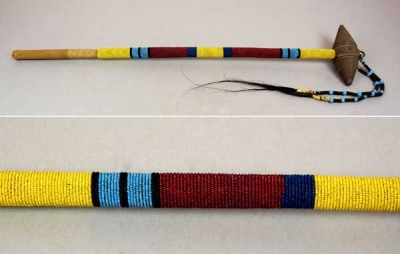Decorative club (1952.10.7)
 CanadaDecorative club from Canada, Americas. Collected by A. Nora Foote (ne�e Field) in 1895. Given to the Museum by Margaret B. Foote in 1952.
CanadaDecorative club from Canada, Americas. Collected by A. Nora Foote (ne�e Field) in 1895. Given to the Museum by Margaret B. Foote in 1952.
Clubs of this type, with a stone head and a wooden handle decorated with strings of coloured beads, are typical of the Central Plains of Canada. They were used not only (as this example was) by the various tribes of the Blackfoot Nation (such as the Peigan and Blood [Kainai]), but also by their enemy neighbours, the Assiniboine, Sioux, Plains Cree, Crow and Gros Ventre. In general however, they were supplanted in the mid-19th century by the gunstock club, which spread into the area up the Missouri river and from the east.
The technique used with this club was to swing it upwards in order to catch the enemy under the chin. The long handle is quite flexible, which works to the weapon's advantage by giving the head a sudden boost of acceleration during the swing prior to the point of contact.
This example is more decorative than functional so is probably of a post-1850 date, of the time when firearms had begun to predominate in warfare. Additional evidence that it may be a ceremonial club is provided by the method of hafting and the extensive bead decoration. Traditionally, stone heads were attached to their handles by tightly bound sapling strips or a rawhide strap. Here, however, the head is attached by the less secure means a metal pin of European-Amercian manufacture. The bands of yellow, red, blue and black beads demonstrate high-quality workmanship and during restoration work after the object's arrival at the Museum in 1952, over 14,000 beads were used.





